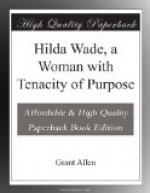It began to strike us now, however, that we had almost overshot the mark in this matter of sanctity. We had made ourselves quite too holy. The monks, who were eager at first to cut our throats, thought so much of us now that we grew a little anxious as to whether they would not wish to keep such devout souls in their midst for ever. As a matter of fact, we spent a whole week against our wills in the monastery, being very well fed and treated meanwhile, yet virtually captives. It was the camera that did it. The Lamas had never seen any photographs before. They asked how these miraculous pictures were produced; and Hilda, to keep up the good impression, showed them how she operated. When a full-length portrait of the chief Lama, in his sacrificial robes, was actually printed off and exhibited before their eyes, their delight knew no bounds. The picture was handed about among the astonished brethren, and received with loud shouts of joy and wonder. Nothing would satisfy them then but that we must photograph every individual monk in the place. Even the Buddha himself, cross-legged and imperturbable, had to sit for his portrait. As he was used to sitting—never, indeed, having done anything else—he came out admirably.
Day after day passed; suns rose and suns set; and it was clear that the monks did not mean to let us leave their precincts in a hurry. Lady Meadowcroft, having recovered by this time from her first fright, began to grow bored. The Buddhists’ ritual ceased to interest her. To vary the monotony, I hit upon an expedient for killing time till our too pressing hosts saw fit to let us depart. They were fond of religious processions of the most protracted sort—dances before the altar, with animal masks or heads, and other weird ceremonial orgies. Hilda, who had read herself up in Buddhist ideas, assured me that all these things were done in order to heap up Karma.
“What is Karma?” I asked, listlessly.
“Karma is good works, or merit. The more praying-wheels you turn, the more bells you ring, the greater the merit. One of the monks is always at work turning the big wheel that moves the bell, so as to heap up merit night and day for the monastery.”
This set me thinking. I soon discovered that, no matter how the wheel is turned, the Karma or merit is equal. It is the turning it that counts, not the personal exertion. There were wheels and bells in convenient situations all over the village, and whoever passed one gave it a twist as he went by, thus piling up Karma for all the inhabitants. Reflecting upon these facts, I was seized with an idea. I got Hilda to take instantaneous photographs of all the monks during a sacred procession, at rapid intervals. In that sunny climate we had no difficulty at all in printing off from the plates as soon as developed. Then I took a small wheel, about the size of an oyster-barrel—the monks had dozens of them—and pasted the photographs inside




